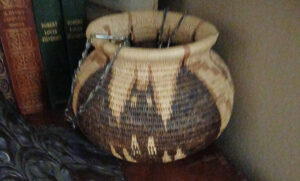 HH owns a lovely ten inch tall Panamanian basket made by indigenous Darien Rainforest artists in the Wounaan tradition. You see a lifelike bat design woven into the fibers. I want to tell you these naturalistic designs have been part of the tradition for thousands of years, but that’s misleading. Not until two European scholars visited the tribe in the 1980s did these baskets bear portrayals of local animals, insects, plants, flowers, trees, and birds. Throughout the ages native people used these non-embellished baskets for storage for water, precious stones, and foodstuffs.
HH owns a lovely ten inch tall Panamanian basket made by indigenous Darien Rainforest artists in the Wounaan tradition. You see a lifelike bat design woven into the fibers. I want to tell you these naturalistic designs have been part of the tradition for thousands of years, but that’s misleading. Not until two European scholars visited the tribe in the 1980s did these baskets bear portrayals of local animals, insects, plants, flowers, trees, and birds. Throughout the ages native people used these non-embellished baskets for storage for water, precious stones, and foodstuffs.
The STYLE of the baskets didn’t change through the years, as the forms passed down from mother to daughter. When the two scholars saw the natural beauty of the forms, they convinced the weaver women that they, the scholars, could sell those baskets. They instructed them to add design elements from the Rainforest or from ancient Pre-Columbian ceramic decorative elements. The scholars asked weavers to commemorate their history on the baskets. To encourage the market for such baskets, the women who formerly wove out of necessity, became “Spirit-Weavers.” Thus, tradition became co-opted, but the new “tradition” grew a worldwide market.
Weavers sourced fibers for the baskets from the Rainforest, from reeds and palm fronds. The Chunga fiber of the black palm is a favorite of the weavers. They stitch fine silk black palm fronds called Werregue, colored with vegetable dyes, over the base coil of Naguala palm. They produced colors for the designs with natural extracts of plants, roots, berries and seed pods, fruits, flowers, and leaves. The name for these baskets is derived form the name of the Wounaan Peoples: “Wounmeu,” the name for the traditional coil constructed palm fiber baskets.
Baskets and Masks
Almost every cultural group on the planet made baskets. Almost every cultural group also made masks, used for social bonding through traditional rituals, or to invoke supernatural powers. I found it fascinating that people during the pandemic who masked seemed less observant of society’s rules of polite decorum! Masks either present a new face to the outside world or hide a face from the outside world.
Wounaan masks were used in the past for a priestly function, to allow the wearer to access higher powers. Today these masks sold on the international marketplace serve decorative purposes, and the spirit figures, woven of fibers, for entertainment. Spiritual leaders wore Wounaan ritual masks formerly as private dance props for the People. Embera shaman incorporated animal and natural figures into woven masks from the visages of birds, horses, cats of all kinds, monkeys, toucans, bears, anteaters, parrots, and deer.
These spirit animals represented various archetypes of the beasts for a ritual purpose, representing the cultural tradition of the Embera, a rainforest Amerindian indigenous group. Once used in healing and cleansing dances for the Wounaan and Embera Peoples, there’s a shop online makes you a Embera mask in the form of your dog for wall décor. A far cry from the animal spirit masks used to dispel an evil spirit, likely responsible for a family member’s severe illness.
HH asked the value of her bat basket
Hard to say because these are fairly new pieces, and available online from $100-250 in this size. She writes that she purchased it for $100 because she suspected it may have been Native American made, which it is not. She suspected it was antique (over 100 years old), which it is not.
There’s no antique market for these baskets with designs, such as we find in the Native America basket weaving tradition, which remained a feature of specific Tribal customs for centuries. This basket is an interesting problem in valuation, because it’s a stylized version of what the “developed” world thinks of as “primitive” traditional basketry. Strangely, this modern art form has a growing market because of its artistry. They’re truly beautifully made, and many are attributed to some of Panama’s best weavers. Some of the larger baskets with more intricate naturalistic designs can sell for thousands of dollars. I wonder how much of that is retained by the weavers, although online sellers claim the money benefits the People….